Abstract
OBJECTIVE--To evaluate the effect of permanent pacing in cardioinhibitory malignant vasovagal syndrome. PATIENTS AND METHODS--37 patients with permanent pacemakers for cardioinhibitory malignant vasovagal syndrome. All presented with syncope (median six episodes, median frequency two episodes a year) and after conventional investigation and invasive electrophysiological assessment they remained undiagnosed, and without a generally accepted indication for pacemaker implantation. In all vasovagal syncope with cardioinhibition (heart rate at syncope < 60 beats/min) developed during tilt tests performed according to the Westminster protocol (head up tilt at 60 degrees with a footplate support for 45 minutes or until syncope intervenes). Dual chamber pacemakers were implanted in 35 (95%) and VVI pacemakers in the remaining two (5%). RESULTS--Over a mean (SD) follow up since implantation of 50.2 (23.9) months symptomatic improvement occurred in 89%: 62% remained free of syncope and 27% were completely symptom free. The collective syncopal burden of these 37 patients was reduced from 136 to 11 episodes each year. During follow up three patients died from unrelated causes. Patients who become asystolic during the tilt test (sinus pause of at least four seconds) experienced no greater benefit from pacing than those with less extreme cardioinhibition. Patients who remained free of syncope since implantation were younger than those who continued to experience syncope. Patients who remained completely symptom free after implantation were younger, more likely to be male, and had had fewer syncopal episodes before implantation than those who continued to experience syncope or presyncope. No other demographic, clinical, investigative, or pacing variable suggested a more favourable outcome after implant. CONCLUSIONS--This retrospective and uncontrolled experience suggests a possible role for permanent pacing in selected patients with cardioinhibitory malignant vasovagal syndrome. Improved acquisition of tilt test data may enable better selection of patients who are suitable for permanent pacing. A randomised prospective study to compare permanent pacing with no treatment or with medical treatment in cardioinhibitory malignant vasovagal syndrome is indicated.
Full text
PDF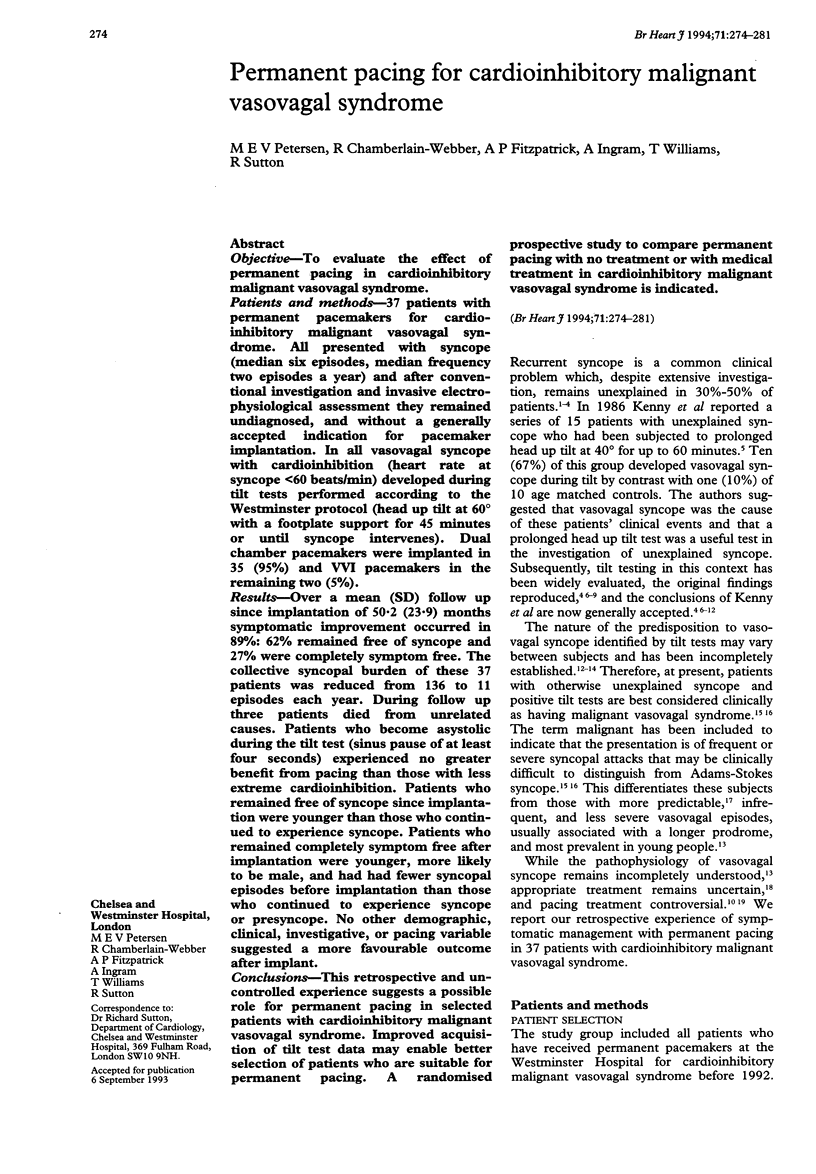
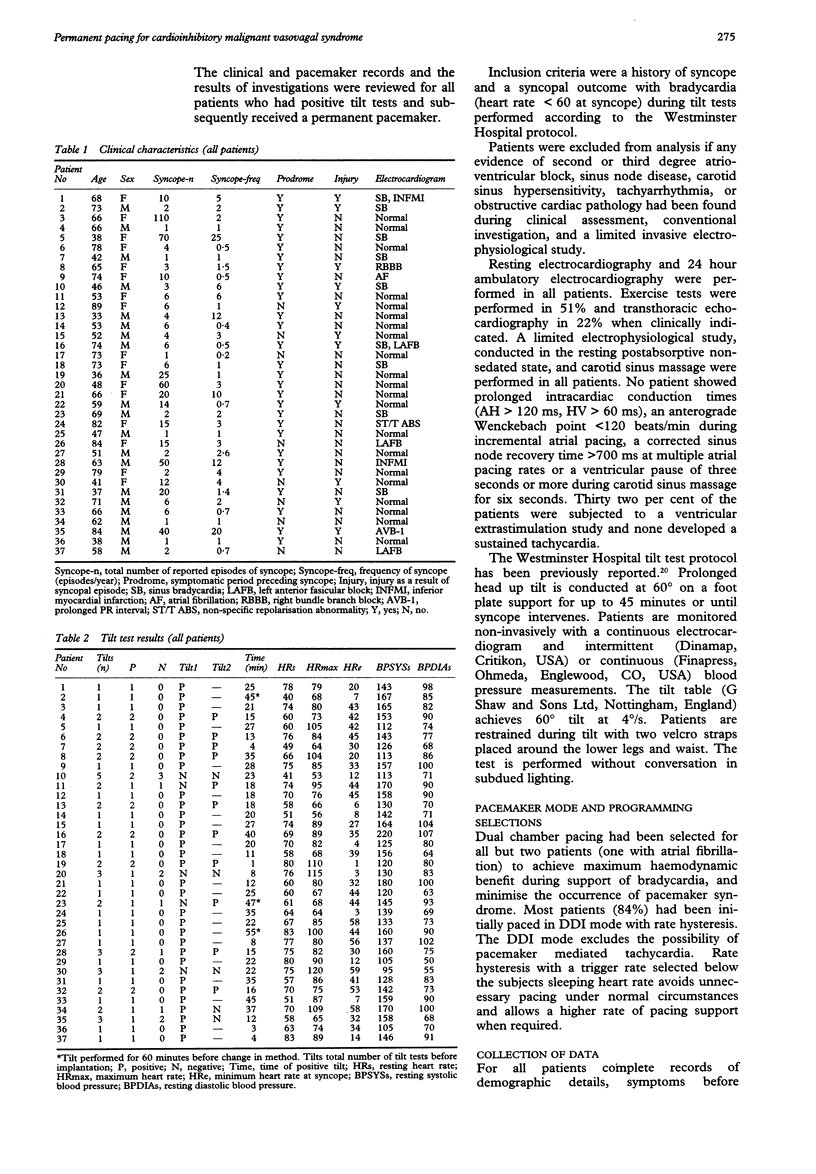
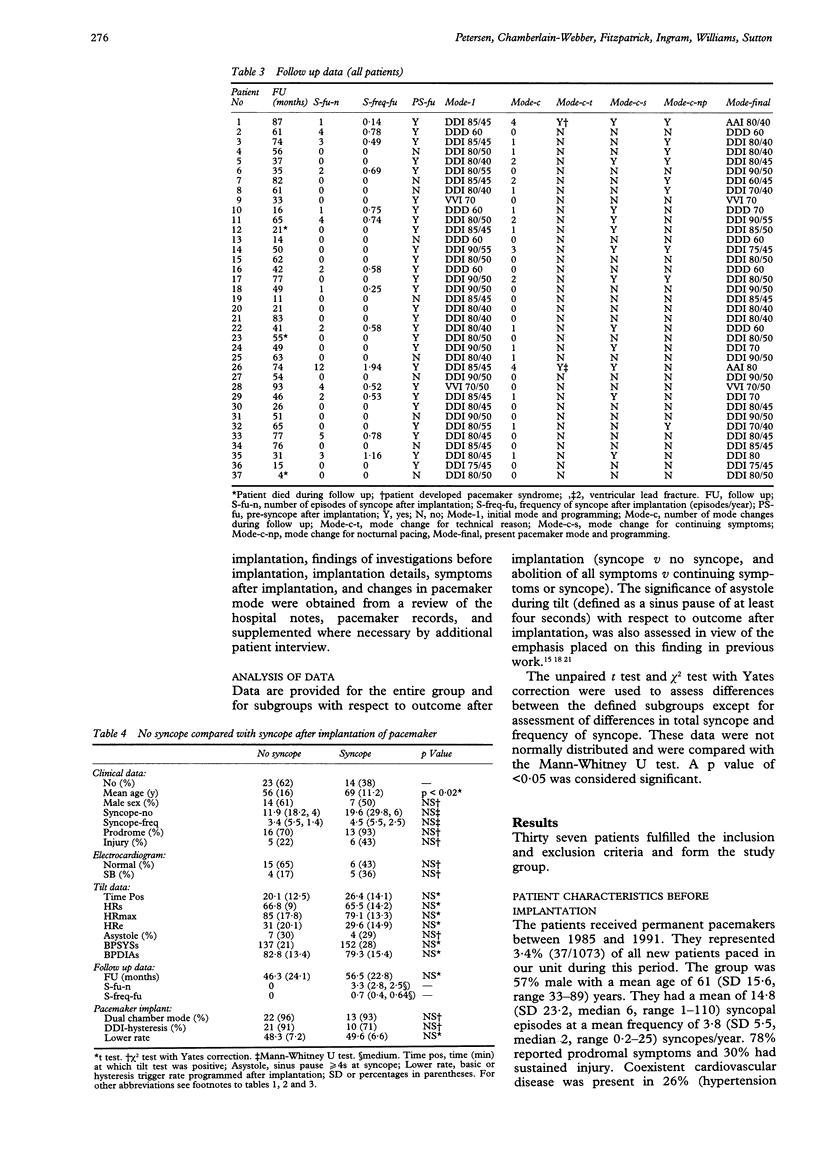
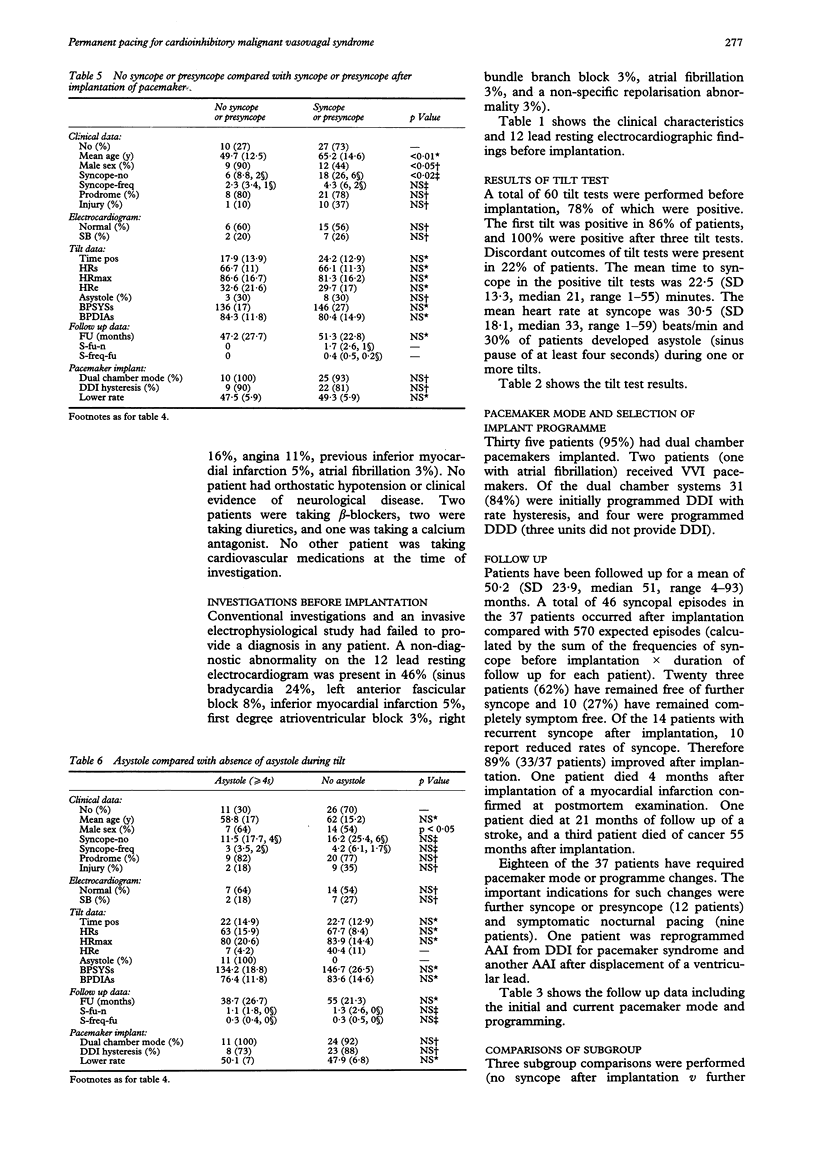
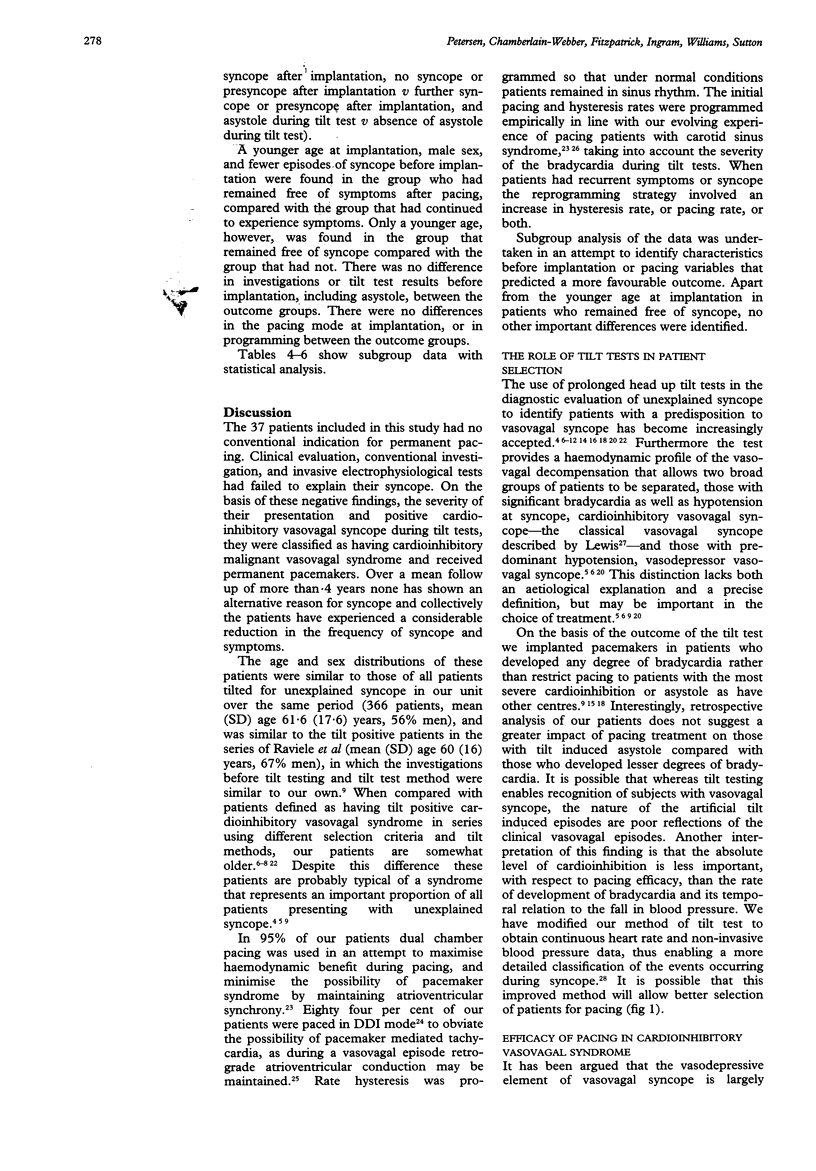
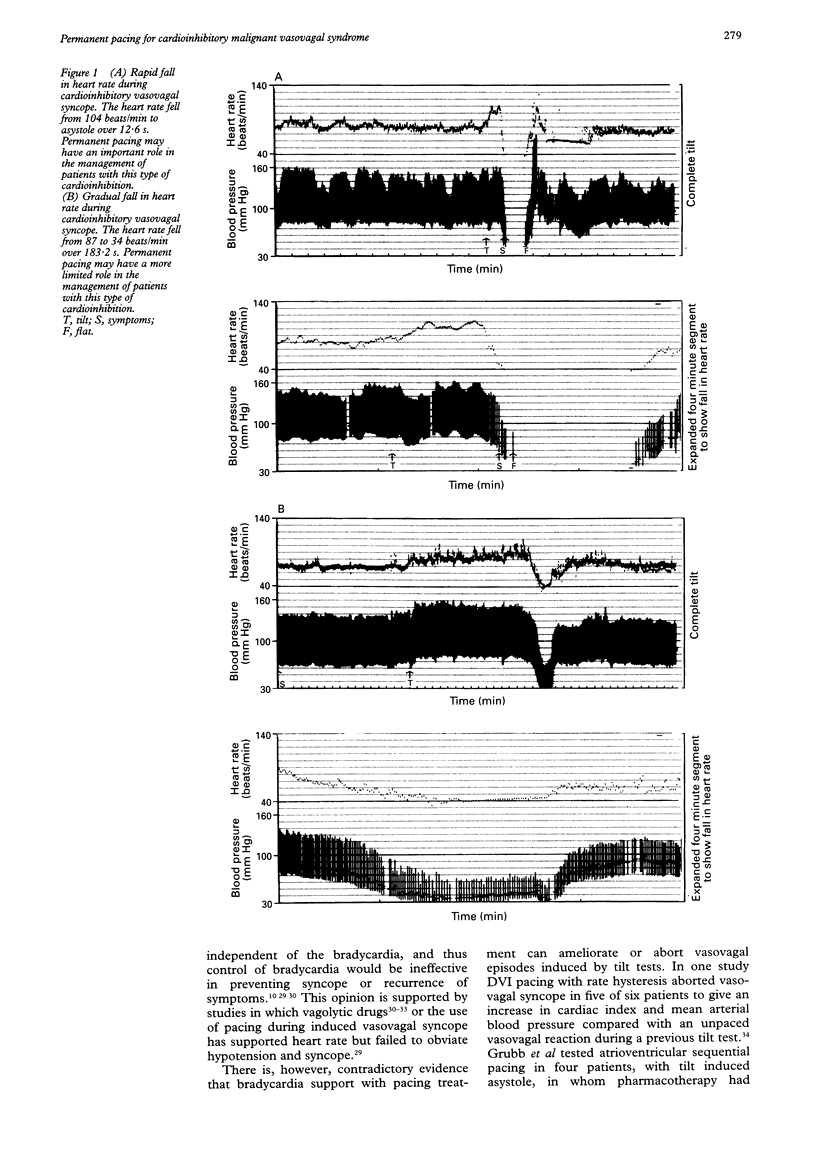
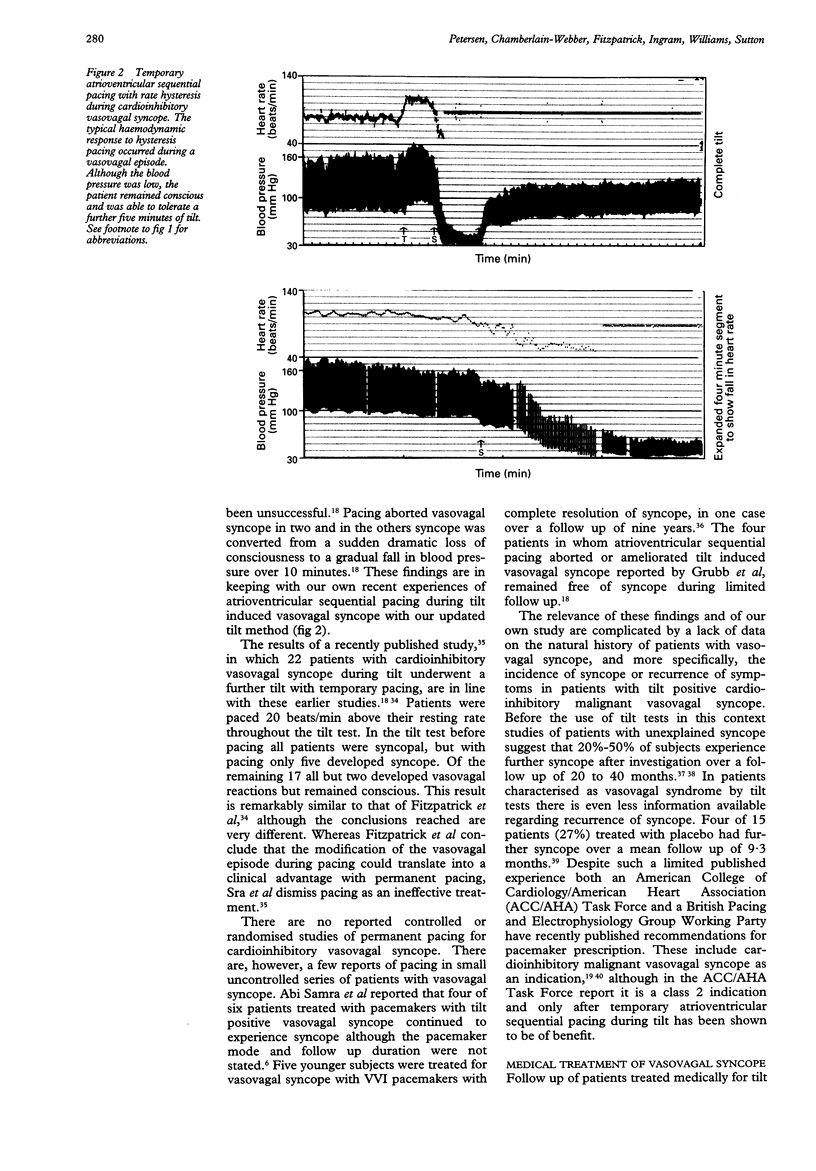
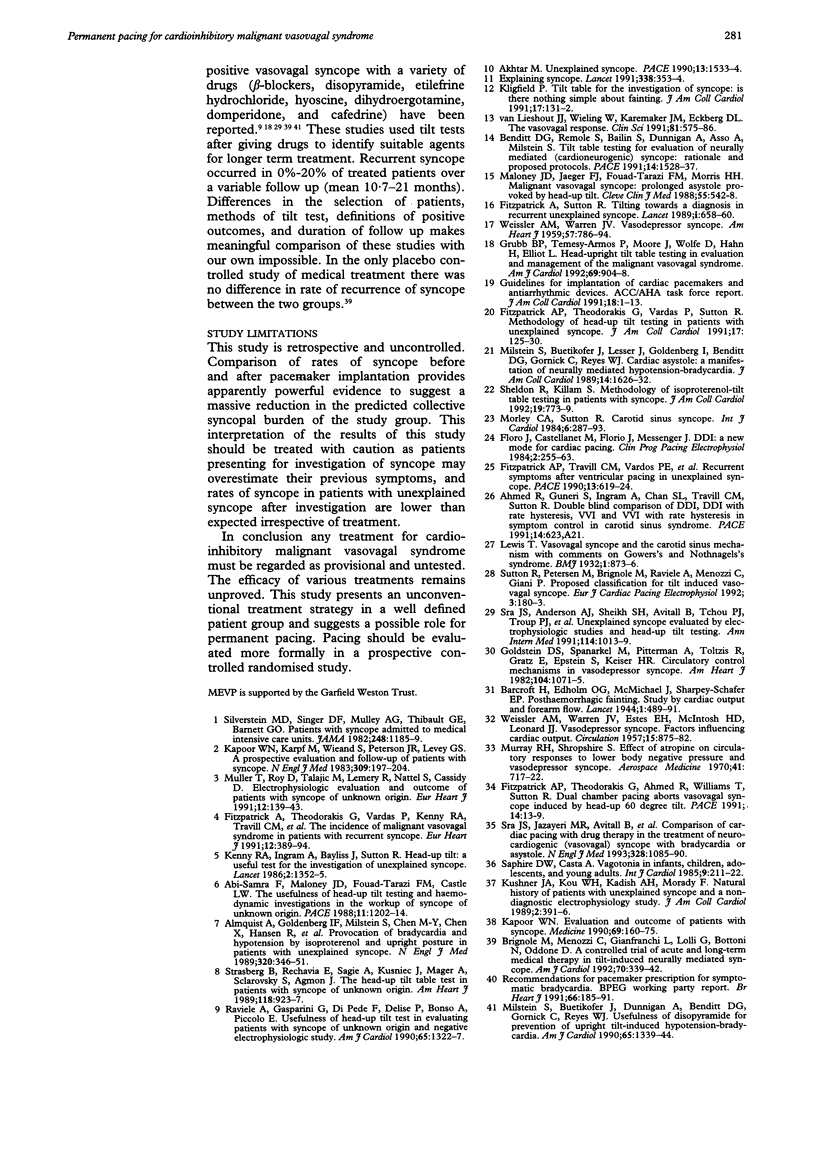
Selected References
These references are in PubMed. This may not be the complete list of references from this article.
- Abi-Samra F., Maloney J. D., Fouad-Tarazi F. M., Castle L. W. The usefulness of head-up tilt testing and hemodynamic investigations in the workup of syncope of unknown origin. Pacing Clin Electrophysiol. 1988 Aug;11(8):1202–1214. doi: 10.1111/j.1540-8159.1988.tb03973.x. [DOI] [PubMed] [Google Scholar]
- Akhtar M. Unexplained syncope. Pacing Clin Electrophysiol. 1990 Nov;13(11 Pt 2):1533–1534. doi: 10.1111/j.1540-8159.1990.tb04035.x. [DOI] [PubMed] [Google Scholar]
- Almquist A., Goldenberg I. F., Milstein S., Chen M. Y., Chen X. C., Hansen R., Gornick C. C., Benditt D. G. Provocation of bradycardia and hypotension by isoproterenol and upright posture in patients with unexplained syncope. N Engl J Med. 1989 Feb 9;320(6):346–351. doi: 10.1056/NEJM198902093200603. [DOI] [PubMed] [Google Scholar]
- Benditt D. G., Remole S., Bailin S., Dunnigan A., Asso A., Milstein S. Tilt table testing for evaluation of neurally-mediated (cardioneurogenic) syncope: rationale and proposed protocols. Pacing Clin Electrophysiol. 1991 Oct;14(10):1528–1537. doi: 10.1111/j.1540-8159.1991.tb04074.x. [DOI] [PubMed] [Google Scholar]
- Brignole M., Menozzi C., Gianfranchi L., Lolli G., Bottoni N., Oddone D. A controlled trial of acute and long-term medical therapy in tilt-induced neurally mediated syncope. Am J Cardiol. 1992 Aug 1;70(3):339–342. doi: 10.1016/0002-9149(92)90615-6. [DOI] [PubMed] [Google Scholar]
- Fitzpatrick A. P., Theodorakis G., Vardas P., Sutton R. Methodology of head-up tilt testing in patients with unexplained syncope. J Am Coll Cardiol. 1991 Jan;17(1):125–130. doi: 10.1016/0735-1097(91)90714-k. [DOI] [PubMed] [Google Scholar]
- Fitzpatrick A. P., Travill C. M., Vardas P. E., Hubbard W. N., Wood A., Ingram A., Sutton R. Recurrent symptoms after ventricular pacing in unexplained syncope. Pacing Clin Electrophysiol. 1990 May;13(5):619–624. doi: 10.1111/j.1540-8159.1990.tb02078.x. [DOI] [PubMed] [Google Scholar]
- Fitzpatrick A., Sutton R. Tilting towards a diagnosis in recurrent unexplained syncope. Lancet. 1989 Mar 25;1(8639):658–660. doi: 10.1016/s0140-6736(89)92155-7. [DOI] [PubMed] [Google Scholar]
- Fitzpatrick A., Theodorakis G., Ahmed R., Williams T., Sutton R. Dual chamber pacing aborts vasovagal syncope induced by head-up 60 degrees tilt. Pacing Clin Electrophysiol. 1991 Jan;14(1):13–19. doi: 10.1111/j.1540-8159.1991.tb04042.x. [DOI] [PubMed] [Google Scholar]
- Fitzpatrick A., Theodorakis G., Vardas P., Kenny R. A., Travill C. M., Ingram A., Sutton R. The incidence of malignant vasovagal syndrome in patients with recurrent syncope. Eur Heart J. 1991 Mar;12(3):389–394. doi: 10.1093/oxfordjournals.eurheartj.a059906. [DOI] [PubMed] [Google Scholar]
- Goldstein D. S., Spanarkel M., Pitterman A., Toltzis R., Gratz E., Epstein S., Keiser H. R. Circulatory control mechanisms in vasodepressor syncope. Am Heart J. 1982 Nov;104(5 Pt 1):1071–1075. doi: 10.1016/0002-8703(82)90442-2. [DOI] [PubMed] [Google Scholar]
- Grubb B. P., Temesy-Armos P., Moore J., Wolfe D., Hahn H., Elliot L. Head-upright tilt-table testing in evaluation and management of the malignant vasovagal syndrome. Am J Cardiol. 1992 Apr 1;69(9):904–908. doi: 10.1016/0002-9149(92)90790-6. [DOI] [PubMed] [Google Scholar]
- Kapoor W. N. Evaluation and outcome of patients with syncope. Medicine (Baltimore) 1990 May;69(3):160–175. doi: 10.1097/00005792-199005000-00004. [DOI] [PubMed] [Google Scholar]
- Kapoor W. N., Karpf M., Wieand S., Peterson J. R., Levey G. S. A prospective evaluation and follow-up of patients with syncope. N Engl J Med. 1983 Jul 28;309(4):197–204. doi: 10.1056/NEJM198307283090401. [DOI] [PubMed] [Google Scholar]
- Kenny R. A., Ingram A., Bayliss J., Sutton R. Head-up tilt: a useful test for investigating unexplained syncope. Lancet. 1986 Jun 14;1(8494):1352–1355. doi: 10.1016/s0140-6736(86)91665-x. [DOI] [PubMed] [Google Scholar]
- Kligfield P. Tilt table for the investigation of syncope: there is nothing simple about fainting. J Am Coll Cardiol. 1991 Jan;17(1):131–132. doi: 10.1016/0735-1097(91)90715-l. [DOI] [PubMed] [Google Scholar]
- Kushner J. A., Kou W. H., Kadish A. H., Morady F. Natural history of patients with unexplained syncope and a nondiagnostic electrophysiologic study. J Am Coll Cardiol. 1989 Aug;14(2):391–396. doi: 10.1016/0735-1097(89)90191-5. [DOI] [PubMed] [Google Scholar]
- Maloney J. D., Jaeger F. J., Fouad-Tarazi F. M., Morris H. H. Malignant vasovagal syncope: prolonged asystole provoked by head-up tilt. Case report and review of diagnosis, pathophysiology, and therapy. Cleve Clin J Med. 1988 Nov-Dec;55(6):542–548. doi: 10.3949/ccjm.55.6.542. [DOI] [PubMed] [Google Scholar]
- Milstein S., Buetikofer J., Dunnigan A., Benditt D. G., Gornick C., Reyes W. J. Usefulness of disopyramide for prevention of upright tilt-induced hypotension-bradycardia. Am J Cardiol. 1990 Jun 1;65(20):1339–1344. doi: 10.1016/0002-9149(90)91324-y. [DOI] [PubMed] [Google Scholar]
- Milstein S., Buetikofer J., Lesser J., Goldenberg I. F., Benditt D. G., Gornick C., Reyes W. J. Cardiac asystole: a manifestation of neurally mediated hypotension-bradycardia. J Am Coll Cardiol. 1989 Dec;14(7):1626–1632. doi: 10.1016/0735-1097(89)90006-5. [DOI] [PubMed] [Google Scholar]
- Morley C. A., Sutton R. Carotid sinus syncope. Int J Cardiol. 1984 Sep;6(3):287–293. doi: 10.1016/0167-5273(84)90188-8. [DOI] [PubMed] [Google Scholar]
- Muller T., Roy D., Talajic M., Lemery R., Nattel S., Cassidy D. Electrophysiologic evaluation and outcome of patients with syncope of unknown origin. Eur Heart J. 1991 Feb;12(2):139–143. doi: 10.1093/oxfordjournals.eurheartj.a059859. [DOI] [PubMed] [Google Scholar]
- Murray R. H., Shropshire S. Effect of atropine on circulatory responses to lower body negative pressure and vasodepressor syncope. Aerosp Med. 1970 Jul;41(7):717–722. [PubMed] [Google Scholar]
- Raviele A., Gasparini G., Di Pede F., Delise P., Bonso A., Piccolo E. Usefulness of head-up tilt test in evaluating patients with syncope of unknown origin and negative electrophysiologic study. Am J Cardiol. 1990 Jun 1;65(20):1322–1327. doi: 10.1016/0002-9149(90)91321-v. [DOI] [PubMed] [Google Scholar]
- Sapire D. W., Casta A. Vagotonia in infants, children, adolescents and young adults. Int J Cardiol. 1985 Oct;9(2):211–224. doi: 10.1016/0167-5273(85)90200-1. [DOI] [PubMed] [Google Scholar]
- Sheldon R., Killam S. Methodology of isoproterenol-tilt table testing in patients with syncope. J Am Coll Cardiol. 1992 Mar 15;19(4):773–779. doi: 10.1016/0735-1097(92)90517-q. [DOI] [PubMed] [Google Scholar]
- Silverstein M. D., Singer D. E., Mulley A. G., Thibault G. E., Barnett G. O. Patients with syncope admitted to medical intensive care units. JAMA. 1982 Sep 10;248(10):1185–1189. [PubMed] [Google Scholar]
- Sra J. S., Anderson A. J., Sheikh S. H., Avitall B., Tchou P. J., Troup P. J., Gilbert C. J., Akhtar M., Jazayeri M. R. Unexplained syncope evaluated by electrophysiologic studies and head-up tilt testing. Ann Intern Med. 1991 Jun 15;114(12):1013–1019. doi: 10.7326/0003-4819-114-12-1013. [DOI] [PubMed] [Google Scholar]
- Sra J. S., Jazayeri M. R., Avitall B., Dhala A., Deshpande S., Blanck Z., Akhtar M. Comparison of cardiac pacing with drug therapy in the treatment of neurocardiogenic (vasovagal) syncope with bradycardia or asystole. N Engl J Med. 1993 Apr 15;328(15):1085–1090. doi: 10.1056/NEJM199304153281504. [DOI] [PubMed] [Google Scholar]
- Strasberg B., Rechavia E., Sagie A., Kusniec J., Mager A., Sclarovsky S., Agmon J. The head-up tilt table test in patients with syncope of unknown origin. Am Heart J. 1989 Nov;118(5 Pt 1):923–927. doi: 10.1016/0002-8703(89)90225-1. [DOI] [PubMed] [Google Scholar]
- WEISSLER A. M., WARREN J. V., ESTES E. H., Jr, MCINTOSH H. D., LEONARD J. J. Vasodepressor syncope; factors influencing cardiac output. Circulation. 1957 Jun;15(6):875–882. doi: 10.1161/01.cir.15.6.875. [DOI] [PubMed] [Google Scholar]
- WEISSLER A. M., WARREN J. V. Vasodepressor syncope. Am Heart J. 1959 May;57(5):786–794. doi: 10.1016/0002-8703(59)90190-5. [DOI] [PubMed] [Google Scholar]
- van Lieshout J. J., Wieling W., Karemaker J. M., Eckberg D. L. The vasovagal response. Clin Sci (Lond) 1991 Nov;81(5):575–586. doi: 10.1042/cs0810575. [DOI] [PubMed] [Google Scholar]


